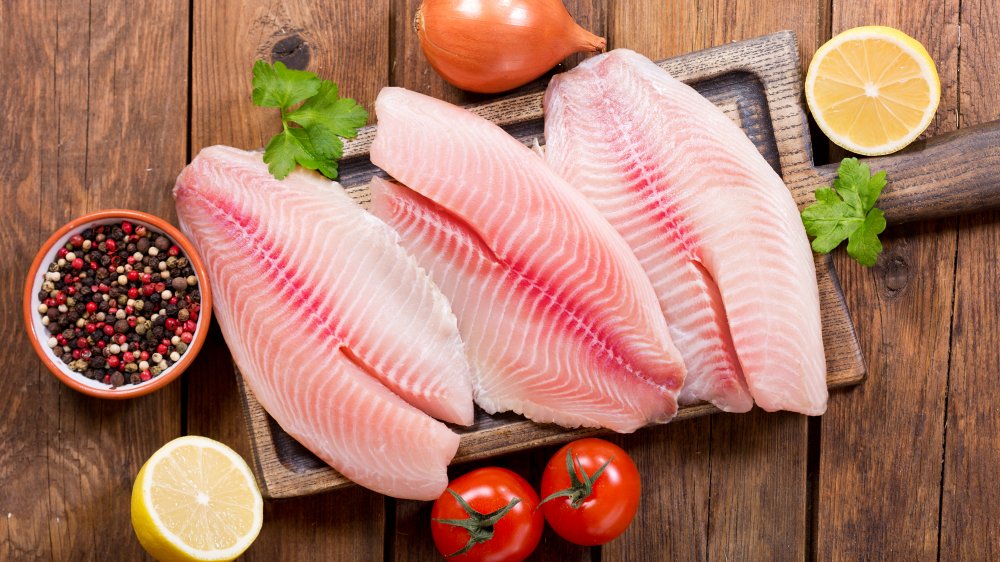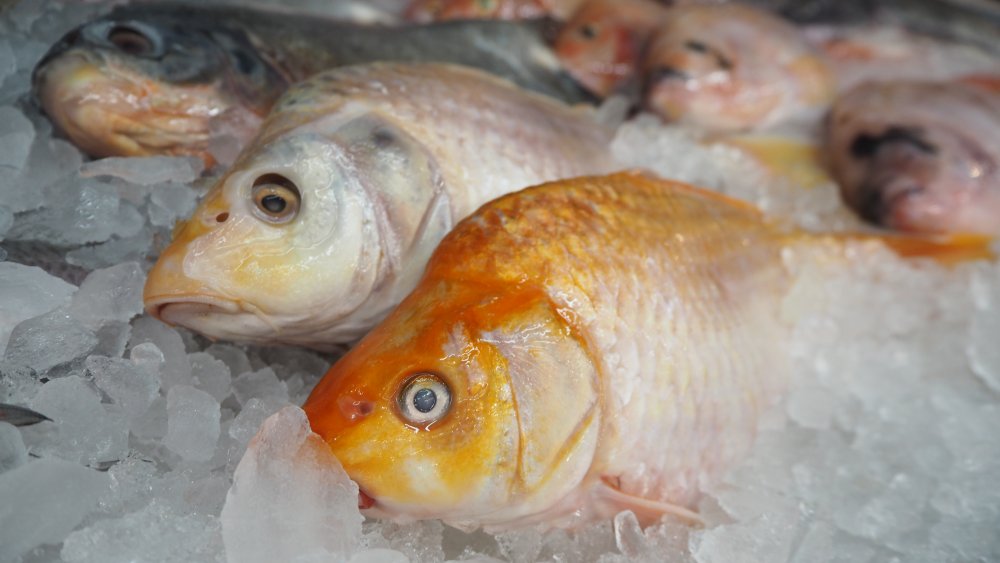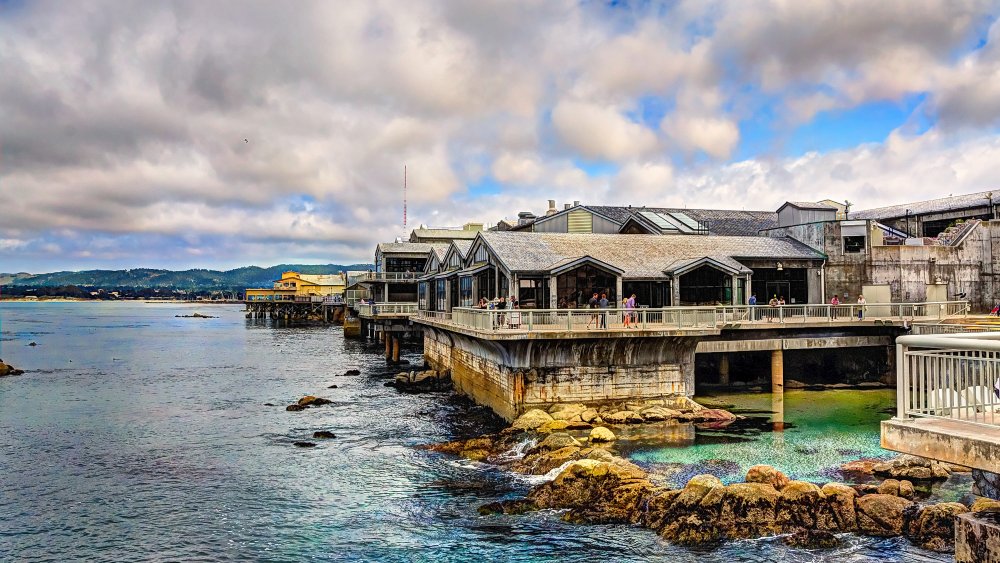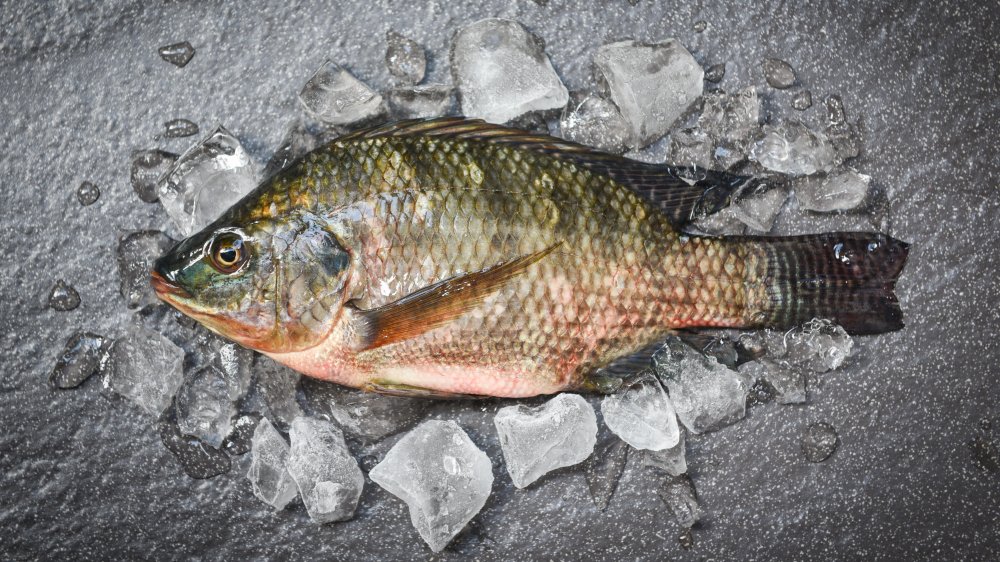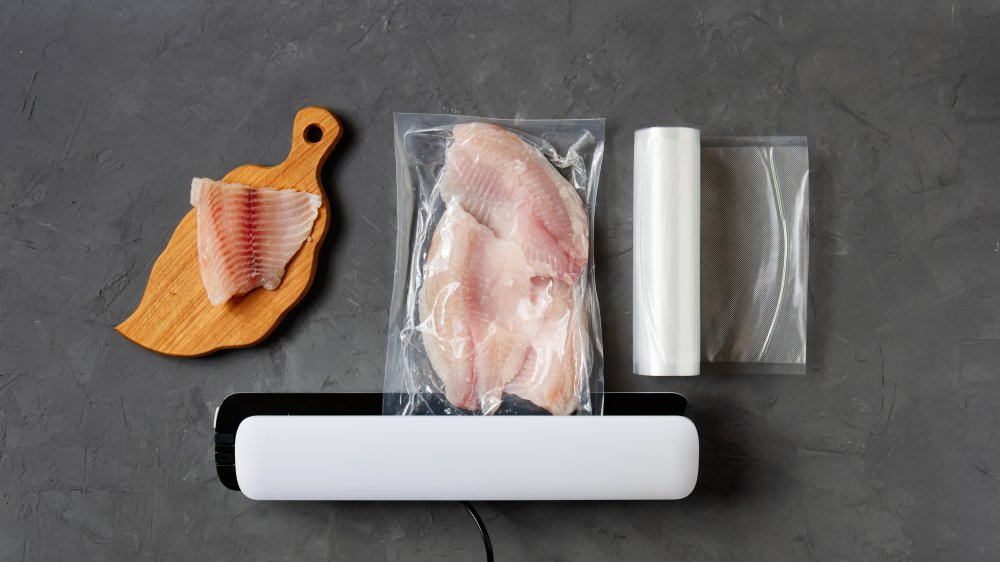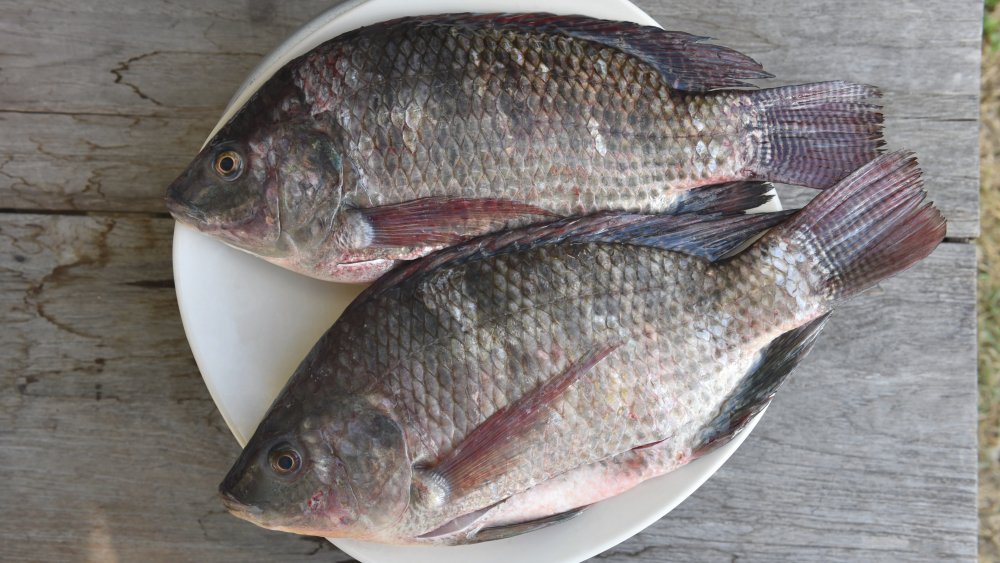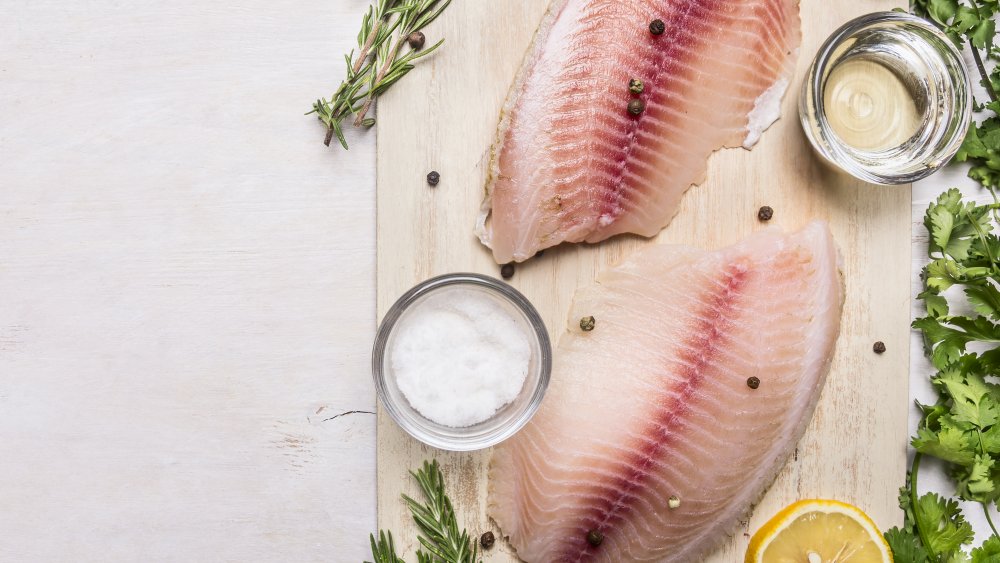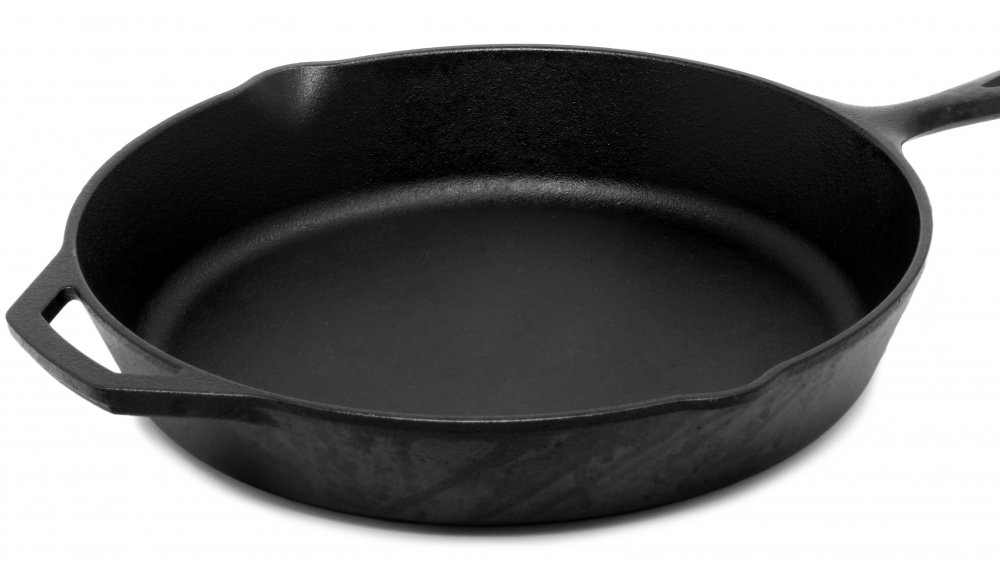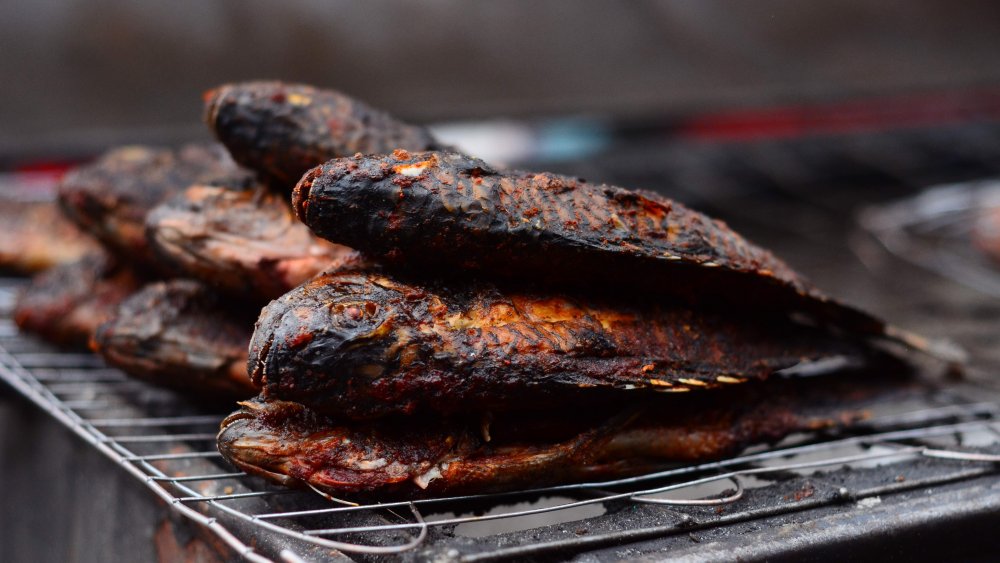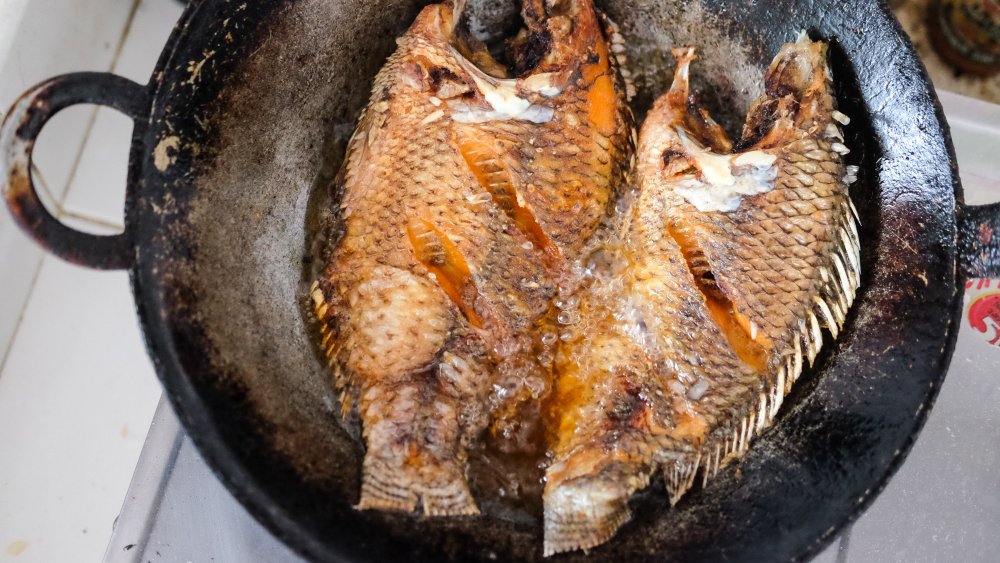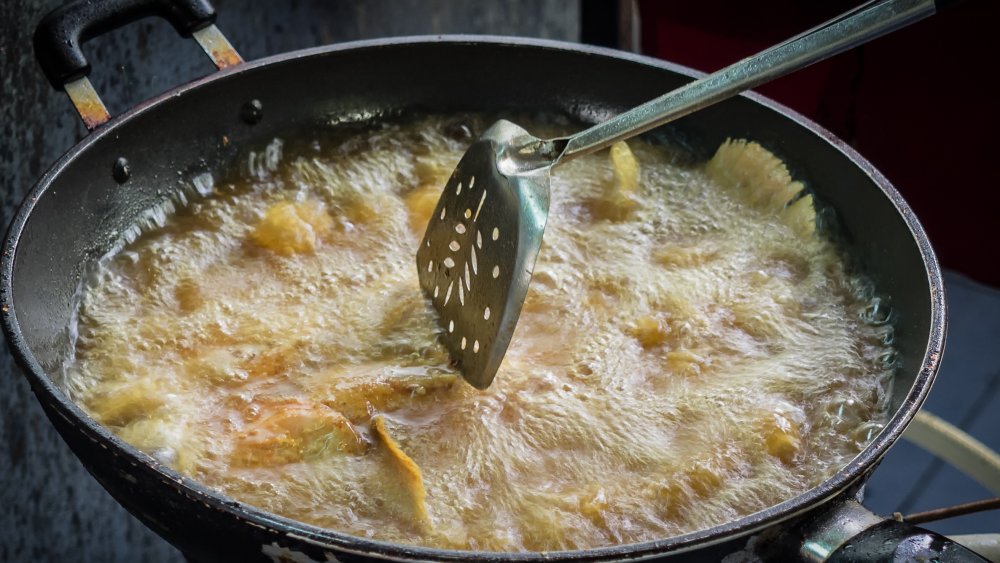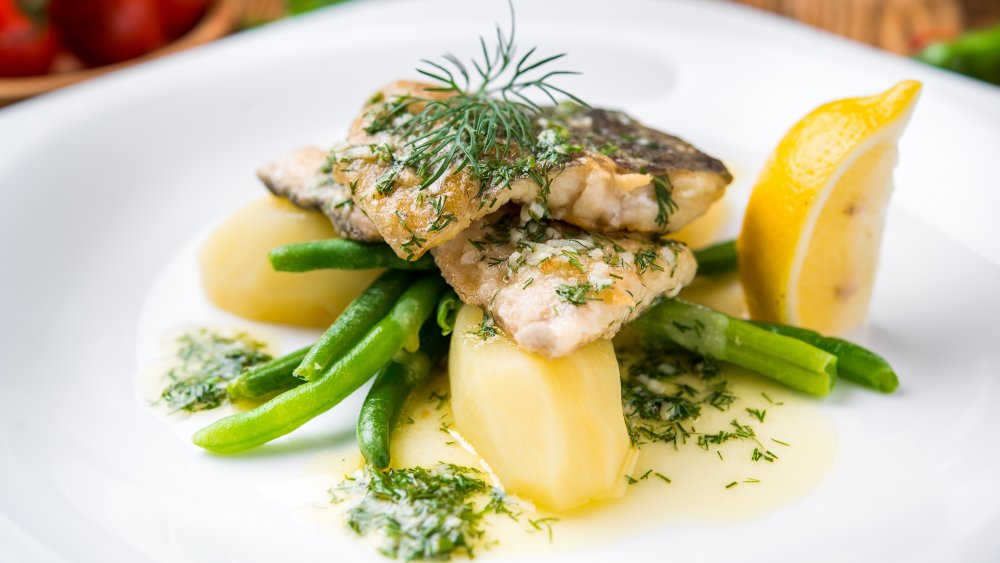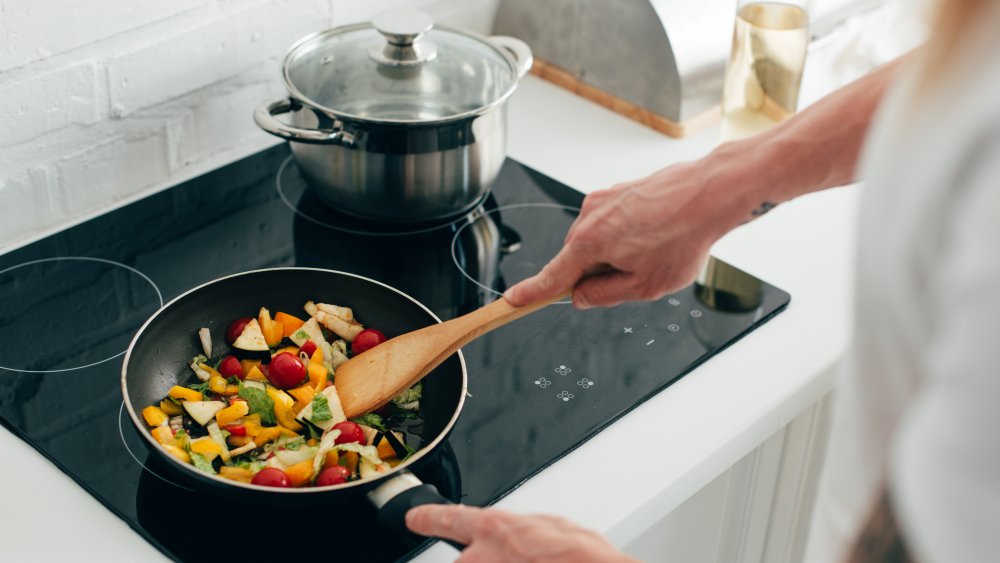Mistakes Everyone Makes When Cooking Tilapia
Tilapia is an easy fish — mild in flavor, readily available, and pretty inexpensive. So, believe us when we say we're not trying to overcomplicate anything. We just want to help you dine on the best-tasting tilapia fillet possible.
Like, tip one, cooking tilapia does not start at the stove like you might think. We suggest it actually starts with a screen. The first thing you need to do is research where to purchase the best tilapia in your neighborhood — there are a few things you should be looking for. We'll also equip you with shopping tips, followed by more work in the kitchen — because you've got to freeze, store, and thaw your tilapia correctly, too.
When it does come to cooking your carefully selected tilapia, there's a right place (pan versus grill, for example) and a right temperature (i.e. searing hot) to make your fillet first-rate.
We present this hopefully helpful outline of ways to not mess up your tilapia with the hopes that you and this ever-present white fish can move forward together, forming a better bond. And that bond also includes seasoning the hell out of it and drowning it in butter... but more on that later.
Not starting with quality tilapia
While the fish found in the frozen food aisle are perfectly edible, it may be wise to head toward the edges of your grocery store. Find the fish counter and have a look at the fresh options behind the glass. Or, if you have the option, it may be more wise to leave the grocery store altogether.
Buying quality tilapia will be easier if there's a reputable seafood market in your neighborhood. Make sure your new fishmonger's shop has a briny smell (similar to the ocean), but doesn't smell offensively "fishy." Start a relationship by hooking him or her into conversation. Ask some questions about their products. Where is this fish from? Is it the freshest you have?
If your fishmonger isn't a conversationalist — or if you're limited to a grocery store selection — there are more ways to spot a good fillet on your own. According to Better Homes & Gardens, fresh fish will have a mild scent, not a strong odor. When buying a whole fish, ensure the eyes are bright and almost bulging, and the gills should be a bright red or pink.
There's also the elasticity test. Press gently on the fish's flesh and let go. A lingering imprint is bad.
Many seafood markets also have newsletters. Subscribe for emails about fresh catches or seafood sales, or just follow them on social media.
Not buying environmentally-friendly tilapia
For the environmentally conscious, the Monterey Bay Aquarium Seafood Watch program offers a well-tested guide, here to help us find seafood that supports a healthy ocean. They're categorized into best choices, good alternatives, and what to avoid. According to the website, the program's recommendations are designed to help consumers shop for seafood that's been fished or farmed in ways that have less of an environment impact. (Can you tell we're fans?)
For tilapia, Seafood Watch recommends we purchase tilapia farmed in raceways in Peru, or from ponds in Ecuador. A best choice is tilapia farmed in indoor recirculating tanks with wastewater treatment. Good alternatives include farms without wastewater treatment, but still recirculating tanks, and countries of origin like Colombia, Honduras, Mexico, Indonesia, and Taiwan. Avoid tilapia that is farmed in China.
Another tip: Find tilapia that is eco-certified by Aquaculture Stewardship Council (ASC), Best Aquaculture Practices (BAP), and Naturland.
Most seafood counters provide information on where their fish comes from. If it doesn't, that may be a sign you need to find a new market. And if you're on the go, there is a Seafood Watch app for iOS and Android.
But what does this have to do with cooking tilapia? A guilt-free dinner will always taste better.
Not storing tilapia the right way
Storing perishable food, from cheese, to veggies, to especially fish, is something that can trip up the most seasoned home cook. Does it stay on the counter? Hit the fridge? Should it stay in any particular neighborhood of the fridge?
It all depends on how you've brought home your fish — if your market wrapped it, of even if you caught it yourself. No matter how you got it, though, fish has to be kept very cold.
If it's in a plastic bag filled with ice, you can place that in the fridge till dinner. But if you have later plans for your tilapia, other measures must be taken to keep it from going bad before you need it.
First, wrap your fish in parchment paper or plastic if it isn't already, and store it using the double bin method. The fish is placed in ice in a container with holes. The melting ice water will drain into the second bin. However, be sure the flesh does not directly touch the ice or water, as it will deteriorate the outer layer of the fish.
Another cool tip involves whole fish (also known as fish in the round), and headed and gutted fish (aka H&G). These fish should be stored surrounded by shaved ice and placed in the same position in which they swim. According to Chef's Resources, this method allows for gravity to do its thing, not effecting the tissue or blood lines, resulting in the least amount of damage to the flesh. Science.
You probably shouldn't freeze tilapia, but if you must, here's how
It's always a good idea to cook fish fresh, the day of the day after you bring it home from the store or fish market. You're first choice shouldn't be to freeze it. As Bon Appetit says, freezing takes away from tilapia's already delicate flavor. But if you must toss your just-brought-home fillet into the freezer, here's how to do it.
Throw your fillets of tilapia into a plastic bags or a storage container beforehand. According to the Food and Drug Administration, lean fish can last up to six to eight months in the freezer.
But if you really want to do this right and have your fish last to up to a year in the freezer, vacuum-seal your fish. But first, according to Food & Wine, dry the filets before vacuum sealing or wrapping in order to keep freezer burn off the fish. Ensure all the air is removed from the freezer bag, seal, and store.
Another method of freezing tilapia is called ice glazing. According to The Spruce Eats, glaze fish by dipping it in cold water, placing it on a sheet pan, and putting it in the freezer. When the water on your fish freezes, take it out, dip again, and repeat till you have a 1/4-inch-thick "glaze" of ice. Deseret News says this method takes time, but does a great job of keeping the fish from drying out.
You're probably thawing your tilapia the wrong way
Thawing is just as important as freezing. Which also means there's a right and a wrong way to do it.
First, please don't put your poor, carefully selected, carefully frozen tilapia in the microwave. According to Bon Appetit, the microwave may shock your fish's flesh, affecting the texture. And even in defrost mode, it may even cook the thinner parts of the fillet.
The Spruce Eats say you also shouldn't thaw at room temperature, i.e. leaving it out on the counter.
Instead, let your fish thaw in the fridge or placed in cold water. When placing your fish in the water, however, keep the packaging or seal on. Directly exposed flesh will suck up water and result in a soggy fillet.
Bon Appetit also says that while you technically can cook certain leaner fish like tilapia straight from the freezer, it's not recommended. More moisture,
Bon Appetit says, can lead to that dreaded sogginess (and will probably make your fish lose a lot of it's flavor).
Forgetting to salt your tilapia before you cook it
There's another way to ensure your tilapia turns our first-rate before you get it cooking: You've got to salt it. Just like with steak, you're free to salt your fish fillet before cooking it.
Cooks Illustrated recommends a 15-minute salting period, followed by patting the fillet dry with a paper towel. This salting session magnifies the mild flavor while keeping the flesh moist. Salt seasons the flesh of your fish and helps it retain moisture, leaving your bite of tilapia moist but not watery.
Recipes all over call for salting your filet. A Hy-Vee Seasons Magazine rundown for pan-fried tilapia starts with cutting tilapia fillets in half, then sprinkling both sides with kosher salt. Let them stand at room temperature for about five minutes. Then pat fish dry.
With recommendations for a 15-minute salt session and a five-minute salt session, it may be best to just split the difference and call it an even 10.
Also, feel free to salt throughout the whole cooking process. According to Food & Wine, the salt doesn't get absorbed after frying. Add some olive oil as you're frying, and continuing to sprinkle with salt and pepper along the way.
You're cooking your tilapia in a cast iron skillet
Cast iron skillets are a blessing. Seeing how the cast iron culture is catching on, many households now have more than one. But should you sauté your tilapia fillet in a cast iron? Bon Appetit says no.
A guide to what and what not to cook in a cast iron skillet mentions tilapia specifically. Sautéing a tilapia in cast iron may muck up your presentation, as the fillet itself tends to flake apart when if you're using a spatula to scrap it up.
Epicurious agrees, reporting that flaky white fish like flounder or tilapia will most likely fall apart when you try to flip it in a cast iron skillet. Or worse yet, stick to the skillet completely, leaving a layer of fish you'd rather be eating seared to your cast iron pan. Instead, Epicurious recommends cooking your fish in a stainless-steel nonstick skillet.
Cooking your tilapia on the grill
For those of us who aren't grill sergeants, taking your cooking outside can be tricky — and that becomes even more true when you start talking about fish. Even though there are tips to cooking perfect seafood on the grill, some fish should probably just stay indoors.
According to The Spruce Eats, tilapia is delicate. It's best served as a fried, steamed, baked, or broiled dish. But you shouldn't eat it raw (sorry, sushi) and you should maybe rethink throwing it on the grill.
However, despite all this, there are ways to cook super delicate fish like cod, flounder, and our hero tilapia on the grill. First, the Seafood Nutrition Partnership recommends you think about using foil or a cedar plank in order to cook fillets.
If you must cook directly on the grill, here's what to keep in mind.
Get a fillet that's at least one inch thick so that it's substantial enough to handle the heat and rough handling of a grill. Also, be sure to clean your grill well before you get started, to ensure your fillet won't stick and break apart when flipping. Don't coat your fish in a sugary glaze, which may burn and blacken from the heat, and finally, only flip once — more than that and your tilapia may just crumble to oblivion.
Not waiting until the pan for your tilapia is properly heated
Imagine all of your tilapia plans being thwarted because you rush things by just a couple of minutes. By this we mean, give your pan some time to heat up before you add the fish. Insider says without a preheated pan, a soggy (and therefore gross) fillet may result. A tragedy after everything you've been through. Your oiled pan should be searing hot.
Hello Fresh, the food delivery service with a cooking blog, has a cool tip for this. If you really want to make sure the oil is hot enough to get cooking, add a few breadcrumbs to see if they sizzle on contact.
Food Network says the result of an unheated pan will be fish that doesn't properly brown. It recommends you wait till you think your pan is probably heated... then wait a few minutes more. It's only then that you add your oil, and then your ingredients.
You're not leaving the tilapia fillet alone when you cook it
If you're pan-frying or sautéing a fillet of tilapia, leave it the heck alone. The globe-trotting Chef Roberto Bellitti told Food & Wine in 2019 that "Fish is very delicate," and this is very true with tilapia. He explains that the more you move tilapia in the pan, the more juice it costs you, which may result in the tender fillet breaking. In other words, the less you push, touch, flip, or shake the fillet, the better it'll be — both in appearance and taste.
But when do you flip your tilapia? It depends on the size and thickness of your fillet, but it's usually after three minutes on one side.
Another piece by Food & Wine gives us a better idea of when to turn your tilapia, since you only get one chance at this. Watch as the flesh changes color from the pan up. When it reaches halfway through the filet, flip, then it's done when the two lines nearly meet.
You're not using enough butter when cooking your tilapia
Remember that line from Julie & Julia, when the frazzled Amy Adams poses an important question: "Is there anything better than butter?" She elaborates. "Think it over: every time you taste something that's delicious beyond imagining and you say, 'What is in this?' — the answer is always going to be butter."
While pan-frying tilapia isn't necessarily a prime example of French cooking, the sentiment can be applied here. You can never have enough butter.
Bon Appetit backs us up here, saying our spotlighted fish definitely tastes best in butter when they presented a specific tilapia recipe. The highlighted recipe is tilapia with balsamic butter sauce, thyme mashed potatoes, and sugar snap peas. The balsamic butter sauce alone calls for a 1/2 cup (or one stick) of butter, plus 1 tablespoon chilled unsalted butter, cut into 1/2-inch cubes, compared with only a 1/4 cup of balsamic vinegar. Do enjoy.
You may be crowding the tilapia in your pan
Home cooks must also be careful with even how many ingredients they're adding to the pan. We're not talking about over seasoning your tilapia — we're talking about over crowing your tilapia.
You may think the more, the better, but an Insider article explains why adding to many tilapia to one pan is a bad thing. When the pan's whole surface is covered with ingredients like fresh-cut vegetables, herbs, or even too many fish fillets, there's no way for the heat to escape. Trapped heat means lots of steam.
Steam is the enemy in this case. Steam keeps meat, especially fish, from turning that desired golden brown you're looking for. The steam, as well as the standing water it sometimes creates in the pan, causes the fish to basically boil. That's no good if you're hoping for a crispy fish, which is usually the case when you're cooking tilapia. Without that nice sear, there's nothing keeping the juices inside. Believe it not, all that steam leads to a dried out tilapia fillet.
That's not to say adding tons of ingredients will always be a no-no, but if you're pan-frying or sauteing, just keep the added-in vegetables to a minimum. If you're making a huge dinner or spread of tilapia, just make them in shifts, keeping the first couple fillets on a plate under a dish towel or some paper towels.
